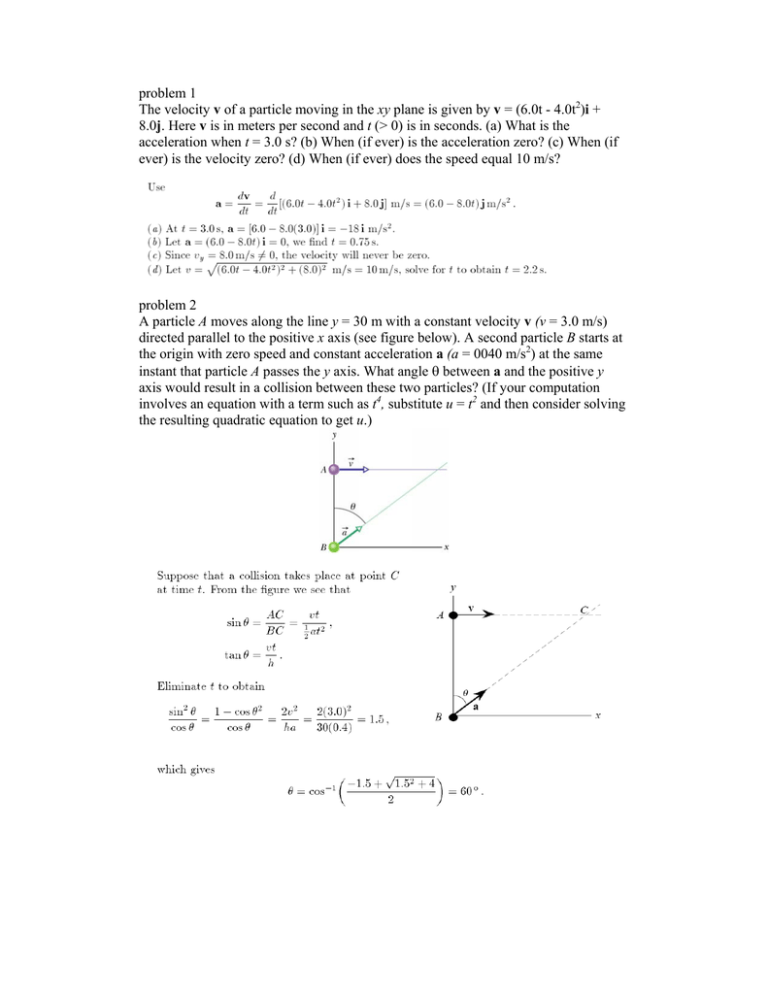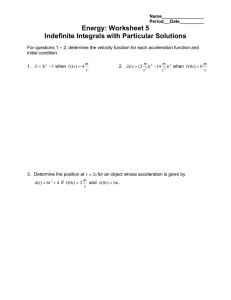problem 1 The velocity v of a particle moving in the xy plane is given
advertisement

problem 1 The velocity v of a particle moving in the xy plane is given by v = (6.0t - 4.0t2)i + 8.0j. Here v is in meters per second and t (> 0) is in seconds. (a) What is the acceleration when t = 3.0 s? (b) When (if ever) is the acceleration zero? (c) When (if ever) is the velocity zero? (d) When (if ever) does the speed equal 10 m/s? problem 2 A particle A moves along the line y = 30 m with a constant velocity v (v = 3.0 m/s) directed parallel to the positive x axis (see figure below). A second particle B starts at the origin with zero speed and constant acceleration a (a = 0040 m/s2) at the same instant that particle A passes the y axis. What angle θ between a and the positive y axis would result in a collision between these two particles? (If your computation involves an equation with a term such as t4, substitute u = t2 and then consider solving the resulting quadratic equation to get u.) Problem 3 Problem 4 Problem 5 problem 6 (a) What is the centripetal acceleration of an object on the Earth's equator owing to the rotation of the Earth? (b) What would the period of rotation of the Earth have to be for objects on the equator to have a centripetal acceleration equal to 9.8 m/s2? problem 7 A carnival Ferris wheel has a 15 m radius and completes five turns about its horizontal axis every minute. (a) What is the period of the motion? (b) What is the centripetal acceleration of a passenger at the highest point? (c) What is the centripetal acceleration at the lowest point? problem 8 A boy whirls a stone in a horizontal circle 2.0 m above the ground by means of a string 1.5 m long. The string breaks, and the stone flies off horizontally and strikes the ground 10 m away. What was the centripetal acceleration of the stone while in circular motion? problem 9 A woman can row a boat at 4.0 mi/h in still water. (a) If she is crossing a river where the current is 2.0 mi/h, in what direction must her boat be headed if she wants to reach a point directly opposite her starting point? (b) If the river is 4.0 mi wide, how long will it take her to cross the river? (c) Suppose that instead of crossing the river she rows 2.0 mi down the river and then back to her starting point. How long will she take? (d) How long will she take to row 2.0 mi up the river and then back to her starting point? (e) In what direction should she head the boat if she wants to cross in the shortest possible time, and what is that time? problem 10 A grindstone (see figure below) has a constant angular acceleration α = 0.35 rad/s2. It starts from rest (that is, ωo = 0) with an arbitrary reference line horizontal, at angular position θo = 0. (a) What is the angular displacement θ of the reference line (hence of the wheel) at t = 18 s? (b) What is the wheel’s angular velocity at t = 18 s? problem 11 What is the angular speed about the polar axis of a point on the Earth's surface at a latitude of 40° N? (b) What is the linear speed? (c) What are the corresponding values for a point at the equator?



